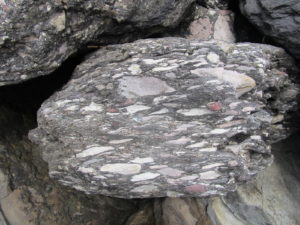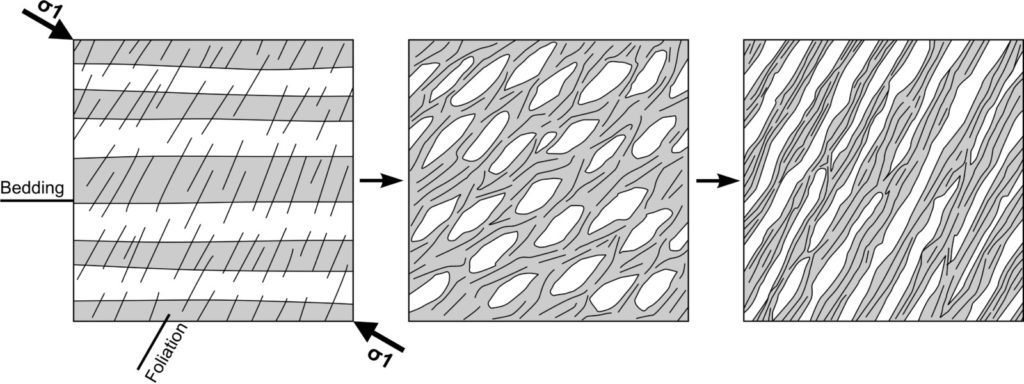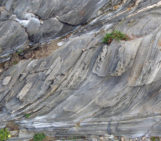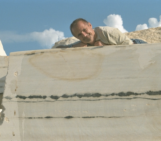
Have you ever walked on a mountain trail, passing past outcrops of rocks and noticed that many rocks appear to be split along a well-defined orientation? If you have, you might have seen one of the most important structures in metamorphic rocks – called foliation.
The term ‘foliation’ derives from the Latin folium, meaning ‘leaf’. A rock with a foliation looks like a pile of ‘leaf-sheets’ that appear piled up one upon the other. Any set of planes that is pervasively repeated in a rock volume defines a foliation, irrespective of its origin, thickness or composition. In the example shown on top of the page, the rock easily splits along foliation surfaces that dip to the left. In this case, the foliation is defined by the preferred orientation of tiny platy minerals – called phyllosilicates – that cause the rock to break apart easily along a specific direction.

Triassic metabreccia from Punta Bianca (La Spezia, Italy). Note the foliation defined by deformed clasts of white marble. The image is 90 cm in width. Photo © Samuele Papeschi
In the example on the left, a deformed breccia, the foliation is defined by clasts that were flattened by tectonic forces and that are now all oriented parallel to each other.
There are many processes that can lead to the development of a foliation in rocks (I will save them for another post). What is important is that a foliation is a pure and simple geometric term, which means that you can use it to describe any pervasive set of planes in a rock, even if you don’t know their origin or composition.
Given this definition, foliations are not restricted just to metamorphic rocks. Bedding planes in sedimentary rocks define a foliation, and so do flow structures in volcanic rocks or compositional bands (schlieren) in intrusive rocks. This kind of foliation is called primary foliation – formed during deposition or igneous crystallization of rocks – to distinguish them from secondary (or tectonic) foliation that develops when rocks are deformed.

There is a foliation inside this granitic dyke from the Calamita Peninsula (Elba Island, Italy). In this case it is defined by black bands rich in tourmaline and changes in grain size. Photo © Samuele Papeschi
Tectonic foliations are widespread in metamorphic rocks. They form as a result of different processes, which require two basic ingredients:
- First, you need deformation processes. Luckily, we are on a trembling planet and at depth rocks are squeezed by tectonic forces.
- Second, you need heat and pressure. You can squeeze rocks as much as you want, but if temperature is not high enough, they will break rather than develop a foliation. Some rocks can deform at relatively low temperature (claystones for instance) while others -for example a granite, require several hundreds of degrees to start deforming.
If all the conditions above are satisfied, congratulations! Your rock will develop a foliation. During deformation, old grains rotate and parallelize with each other. Eventually, new minerals will grow already oriented parallel to the foliation. This is because the foliation plane lies perpendicular to the direction of maximum tectonic force (called stress in geology) and mineral grains find less resistance to their growth along the foliation plane. Difficult? Here is a sketched example, modified after Raymond (1995).

The progressive development of a foliation overprints primary structures leading to the development of a new, metamorphic structure. Redrawn after Raymond (1995).
The more deformation goes on, the more primary structures are obliterated. A foliation progressively overprints primary structures, becoming more and more penetrative as deformation continues. If rocks face only limited deformation or are deformed at relative low temperatures, they can preserve original structures, but if the intensity of deformation or temperature (or both) are high, primary structures will likely be destroyed.
We have barely started to scratch the surface of this interesting topic. In the next chapters of the ‘Features from the Field’ series I will look in greater detail at the complicated world of foliation. Stay tuned!
References and further reading
Dieterich, J.H., 1969. Origin of cleavage in folded rocks. American Journal of Science 267, 155-165.
Fossen, H., 2016. Structural Geology. Cambridge University Press.
Ramsay, J.G., and Huber, M.I., 1983. The techniques of Modern Structural Geology. Vol. 1: Strain Analysis. Academic Press, London.
Raymond, L. A., 1995. Petrology: the study of igneous, sedimentary, metamorphic rocks. Dubuque, IA : Wm. C. Brown (editors)





Mohammed Dan-Hassan, PhD.
An important element in structural geology explained in simple, clear and concise manner.
Great contribution to fundamentals of Structures.
Samuele Papeschi
Thank you very much, Mohammed!
Igbudu Blessing
The Thanks for this wonderful content. It was very insightful and enjoyable. I have learnt a lot from reading this article.
Samuele Papeschi
Thank you very much, Igbudu!